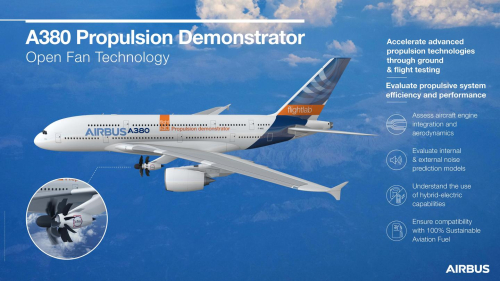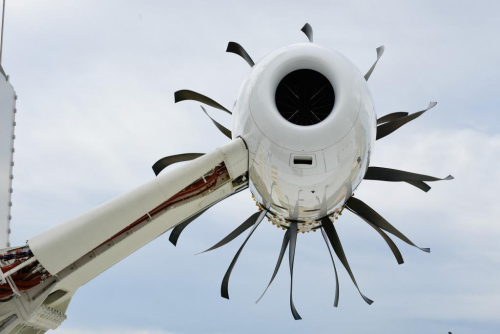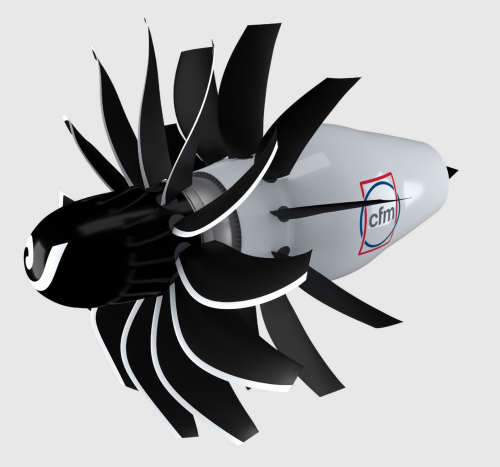[ad_1]
The open fan structure is a key element of aero engine maker CFM Worldwide’s “Revolutionary Innovation for Sustainable Engines” (RISE) expertise growth program (earlier publish), which goals to reveal and mature a variety of recent applied sciences for future engines that would enter service by the mid-2030s.
Open fan expertise may even be the main target of a significant Airbus flight demonstration marketing campaign to be carried out in collaboration with CFM within the second half of this decade. The joint demonstration program will use shared flight check belongings. Provisionally the plan is for CFM to carry out engine floor checks, together with flight check validation at GE Aviation’s Flight Take a look at Operations middle in Victorville, California.
A second section of flight checks might be carried out from the Airbus flight check facility in Toulouse, France, within the second half of the last decade. For these checks, the open fan engine might be mounted below the wing of a specifically configured and instrumented A380 testbed plane.
The joint Airbus and CFM targets for the open fan joint demonstration on the A380 are in depth. The high-level objectives embody: analysis of open fan propulsive effectivity and efficiency on an plane; acceleration and maturity of applied sciences by way of floor testing; evaluation of plane/engine integration and aerodynamics (thrust, drag, masses); and analysis of inside and exterior noise ranges.
Prediction capabilities are key to search out the correct design that meets each the gasoline effectivity and the acoustic targets (for the communities round airports and in addition for passengers contained in the cabin). As a result of CFM’s engine and the wing might be very close-coupled, these capabilities should be developed in shut collaboration.
As well as, Airbus and CFM will collaborate on understanding the usage of hybrid-electric capabilities and guaranteeing compatibility with 100% Sustainable Aviation Gasoline (SAF).
Getting ready the {hardware} for flight checks. Nevertheless, earlier than any of the above targets could be investigated, between now and the primary demonstration flight within the second half of the last decade, an intensive section of Engineering preparatory work is deliberate.
We are going to first want to find out the flight physics constraints, design and assessments for the flight-test demonstration (FTD) engine set up. These will embody: definition of the pylon ‘aero-lines’ (ie. the aerodynamics and bodily geometries), evaluation of masses, dealing with qualities and efficiency and preparation of modeling to help flight-test evaluation.
—Pascal Arrouy, Airbus’ Open Fan Architect within the “Propulsion of Tomorrow” R&T program
As well as, the pylon with the engine mounts and attachment might be collectively designed for minimizing weight and vibration transmission to the cabin, in addition to engine system integration. The fuselage construction affected by the propulsion system influence may even be studied.
Numerous plane techniques may even must be modified and preparatory checks carried out to make sure that the behaviour of the A380 flight check plane with an open fan engine put in could be properly understood for flight clearance and knowledge validity.
Particular areas of focus will embody: energy administration (together with open fan compatibility with hybrid-electric plane architectures); integration of the engine management techniques; flight controls optimization; gasoline distribution; vibration evaluation, and instrumentation set up.
As soon as all these actions are full, we will transfer to the subsequent section which is the bodily manufacture and meeting of the modifications to the plane together with the brand new personalized pylon. This might be adopted by particular checks on engine elements to help the file wanted for final flight clearance of the entire bundle.
—Pascal Arrouy
Contained in the plane, workstations might be put in to accommodate devoted flight check engineers and technicians, who will monitor and measure the in-flight efficiency of the assorted mission system sensors put in. To this finish the plane might be closely instrumented with lots of of sensors, together with microphones, accelerometers, static stress sensors and cameras.
Open fan background. Within the mid-Eighties GE developed and flight-tested the GE36 “Unducted Fan” (UDF) engine demonstrator. The GE36 UDF relied on a ahead fan that was pushed by a devoted turbine, whereas the rear fan was pushed by one other turbine which rotated in the other way.
The GE36 UDF demonstrator on the bottom check stand in 1985.
Quick-forward to 2017, when as a part of a European Clear Sky initiative, Safran had developed a revitalized “Contra-Rotating-Open-Rotor” (CROR) idea and subsequently ground-tested it. CROR and the GE36 had been each pusher configurations (blades on the rear) that includes two units of fan blades which rotated in opposing instructions.
Safran CROR.
Constructing on the CROR analysis, CFM’s open fan demonstrator contains many enhancements and simplifications. This can be a puller configuration (blades on the entrance) the place the rear set of blades doesn’t rotate.
These rear blades are successfully a set of variable-pitch ‘stators’ which may effectively manipulate the thrust airflow generated by the rotating entrance set, whereas additional lowering mechanical complexity, weight and noise. With this alteration, the engine can direct air move to fly at speeds in line with typical turbo fan engine architectures and ship an improved cabin expertise for passengers.
[ad_2]




